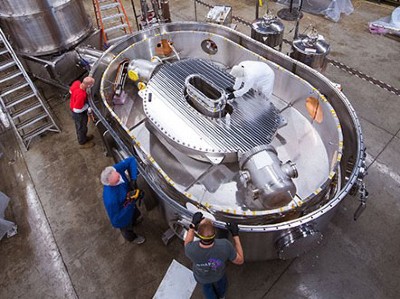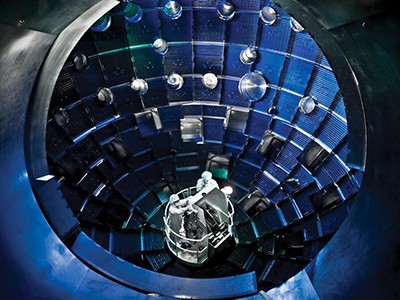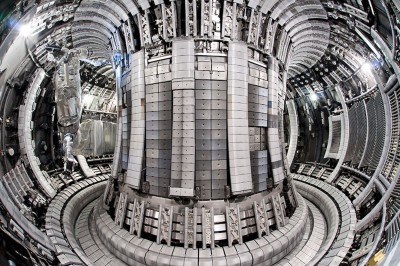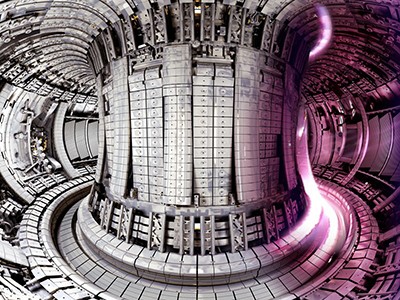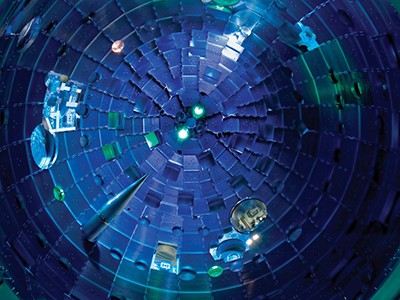Scientists at the world’s largest nuclear-fusion facility have for the first time achieved the phenomenon known as ignition — creating a nuclear reaction that generates more energy than it consumes. Results of the breakthrough at the US National Ignition Facility (NIF), conducted on 5 December and announced today by US President Joe Biden’s administration, has excited the global fusion-research community. That research aims to harness nuclear fusion — the phenomenon that powers the Sun — to provide a source of near-limitless clean energy on Earth.
The chase for fusion energy
“It’s an incredible accomplishment,” says Mark Herrmann, the deputy director for fundamental weapons physics at Lawrence Livermore National Laboratory in California, which houses the fusion laboratory. The landmark experiment follows years of work by multiple teams on everything from lasers and optics to targets and computer models, Herrmann says. “That is of course what we are celebrating.”
A flagship experimental facility of the US Department of Energy’s nuclear-weapons programme that was designed to study thermonuclear explosions, NIF originally aimed to achieve ignition by 2012 and has faced criticism for delays and cost overruns. In August 2021, NIF scientists announced that they had used their high-powered laser device to achieve a record reaction that crossed a critical threshold on the path to ignition, but efforts to replicate that experiment, or shot, in the following months fell short. Ultimately, scientists scrapped efforts to replicate that shot and rethink the experimental design — an effort that paid off last week.
“There were a lot of people who didn’t think it was possible, but I and others who kept the faith feel somewhat vindicated,” says Michael Campbell, former director of the fusion laboratory at the University of Rochester in New York and an early proponent of NIF while at Lawrence Livermore lab. “I’m having a cosmo to celebrate.”
Nature looks at NIF’s latest experiment and what it means for fusion science.
What did NIF achieve?
The facility used its set of 192 lasers to deliver 2.05 megajoules of energy onto a pea-sized gold cylinder containing a frozen pellet of the hydrogen isotopes deuterium and tritium. The pulse of energy caused the capsule to collapse, creating temperatures only seen in stars and thermonuclear weapons, and the hydrogen isotopes fused into helium, releasing additional energy and creating a cascade of fusion reactions. The laboratory’s analysis suggests that the reaction released some 3.15 megajoules of energy — roughly 54% more than the energy that went into the reaction, and more than double the previous record of 1.3 megajoules.
US achieves laser-fusion record: what it means for nuclear-weapons research
“Fusion research has been going on since the early 1950s, and this is the first time in the laboratory that fusion has ever produced more energy than it consumed,” says Campbell.
The experiment safely qualifies as ignition, a benchmark measure for fusion reactions that focuses on how much energy went into the target compared to how much energy was released. However, while the fusion reactions may have produced more than 3 megajoules of energy — more than was delivered to the target — NIF’s 192 lasers consumed 322 megajoules of energy in the process.
“It’s a big milestone, but NIF is not a fusion-energy device,” says Dave Hammer, a nuclear engineer at Cornell University in Ithaca, New York.
Herrmann acknowledges as much, saying that there are many steps on the path to laser fusion energy. “NIF was not designed to be efficient,” he says. “It was designed to be the biggest laser we could possibly build to give us the data we need for the [nuclear] stockpile research programme.”
Nuclear-fusion reactor smashes energy record
To achieve ignition, NIF scientists made multiple changes before the latest laser shot, based in part on analysis and computer modelling of the experiments conducted last year. In addition to boosting the laser power by around 8%, scientists created a target with fewer imperfections and adjusted how the laser energy was delivered onto the target to create a more spherical implosion. Scientists knew they were operating at the cusp of fusion ignition, and in that regime, Herrmann says, “little changes can make a big difference”.
Why are these results significant?
At one level, it’s about proving what is possible, and on that front many scientists have hailed the result as a milestone in fusion science. But the results carry particular significance at NIF: the facility was designed to help nuclear-weapons scientists to study the intense heat and pressures in explosions, and that is possible only if the facility produces high-yield fusion reactions.
It took more than a decade, “but they can be commended for reaching their goal”, says Stephen Bodner, a physicist who formerly headed the laser-fusion programme at the US Naval Research Laboratory in Washington DC. Bodner says the big question now is what the Department of Energy will do next: double down on weapons research at NIF or pivot to a laser programme geared towards fusion-energy research.
What does this mean for fusion energy?
The latest results have already renewed buzz about a future powered by clean fusion energy, but experts warn that there is a long road ahead.
NIF was not designed with commercial fusion energy in mind — and many researchers doubt that laser-driven fusion will be the approach that ultimately yields fusion energy. But Campbell believes that its latest success could boost confidence in the promise of laser fusion power and open the door to a programme focused on energy applications. “This is absolutely necessary to have the credibility to sell an energy programme,” he says.
Lawrence Livermore laboratory director Kim Budil described the achievement as a proof of concept. “I don’t want to give you a sense that we’re going to plug the NIF into the grid: that is definitely not how this works,” she said during a press conference in Washington DC. “But this is the fundamental building block of an inertial confinement fusion power scheme.”
Fuel for world’s largest fusion reactor ITER is set for test run
There are many other fusion experiments worldwide that are trying to achieve fusion for energy applications using different approaches. But engineering challenges remain, including the design and construction of plants that can extract the heat produced by the fusion and use it to generate significant amounts of energy that can be turned into usable electricity.
“Although positive news, this result is still a long way from the actual energy gain required for the production of electricity,” said Tony Roulstone, a nuclear-energy researcher at the University of Cambridge, UK, in a statement to the Science Media Centre.
Still, “the NIF experiments focused on fusion energy absolutely are valuable on the path to commercial fusion power”, says Anne White, a plasma physicist at the Massachusetts Institute of Technology in Cambridge.
What are the next major milestones in fusion?
To demonstrate that the type of fusion studied at NIF can be a viable way of producing energy, the efficiency of the yield — the energy released compared to the energy that goes into producing the laser pulses — needs to grow by at least two orders of magnitude.
Laser-fusion facility heads back to the drawing board
Researchers will also need to dramatically increase the rate at which the lasers can produce the pulses and how quickly they can clear the target chamber to prepare it for another burn, says Time Luce, head of science and operation at the international nuclear-fusion project ITER, which is under construction in St-Paul-lez-Durance, France.
“Sufficient fusion-energy-producing events at repeated performance would be a major milestone of interest,” says White.
The US$22-billion ITER project — a collaboration between China, the European Union, India, Japan, Korea, Russia and the United States — aims to achieve self-sustaining fusion, meaning that the energy from fusion produces more fusion, through a different technique from NIF’s ‘inertial confinement’ approach. ITER will keep a plasma of deuterium and tritium confined in a toroidal vacuum chamber, or tokamak, and heat it up until the nuclei fuse. When it starts doing so in 2035, it will aim to reach ‘burning’ stage, Luce explains “where the self-heating power is the dominant source of heating”. Such self-sustaining fusion is the key to producing more energy than what is put in.
What does it mean for other fusion experiments?
NIF and ITER are two fusion technology concepts among many being pursued worldide. The approaches include magnetic confinement of plasma — used by tokamaks and stellarators — inertial confinement, used by NIF, and a hybrid.
The technology required to make electricity from fusion is largely independent of the concept, says White, and the latest milestone won’t necessarily lead to researchers abandoning or consolidating concepts.
The engineering challenges faced by NIF are different from those at ITER and other facilities. But the symbolic achievement could have widespread effects. “A result like this will bring increased interest in the progress of all types of fusion, so it should have a positive impact on fusion research in general,” says Luce.


